Masayoshi Tomizuka
Everything-Grasping (EG) Gripper: A Universal Gripper with Synergistic Suction-Grasping Capabilities for Cross-Scale and Cross-State Manipulation
Oct 06, 2025Abstract:Grasping objects across vastly different sizes and physical states-including both solids and liquids-with a single robotic gripper remains a fundamental challenge in soft robotics. We present the Everything-Grasping (EG) Gripper, a soft end-effector that synergistically integrates distributed surface suction with internal granular jamming, enabling cross-scale and cross-state manipulation without requiring airtight sealing at the contact interface with target objects. The EG Gripper can handle objects with surface areas ranging from sub-millimeter scale 0.2 mm2 (glass bead) to over 62,000 mm2 (A4 sized paper and woven bag), enabling manipulation of objects nearly 3,500X smaller and 88X larger than its own contact area (approximated at 707 mm2 for a 30 mm-diameter base). We further introduce a tactile sensing framework that combines liquid detection and pressure-based suction feedback, enabling real-time differentiation between solid and liquid targets. Guided by the actile-Inferred Grasping Mode Selection (TIGMS) algorithm, the gripper autonomously selects grasping modes based on distributed pressure and voltage signals. Experiments across diverse tasks-including underwater grasping, fragile object handling, and liquid capture-demonstrate robust and repeatable performance. To our knowledge, this is the first soft gripper to reliably grasp both solid and liquid objects across scales using a unified compliant architecture.
Programmable Locking Cells (PLC) for Modular Robots with High Stiffness Tunability and Morphological Adaptability
Sep 09, 2025Abstract:Robotic systems operating in unstructured environments require the ability to switch between compliant and rigid states to perform diverse tasks such as adaptive grasping, high-force manipulation, shape holding, and navigation in constrained spaces, among others. However, many existing variable stiffness solutions rely on complex actuation schemes, continuous input power, or monolithic designs, limiting their modularity and scalability. This paper presents the Programmable Locking Cell (PLC)-a modular, tendon-driven unit that achieves discrete stiffness modulation through mechanically interlocked joints actuated by cable tension. Each unit transitions between compliant and firm states via structural engagement, and the assembled system exhibits high stiffness variation-up to 950% per unit-without susceptibility to damage under high payload in the firm state. Multiple PLC units can be assembled into reconfigurable robotic structures with spatially programmable stiffness. We validate the design through two functional prototypes: (1) a variable-stiffness gripper capable of adaptive grasping, firm holding, and in-hand manipulation; and (2) a pipe-traversing robot composed of serial PLC units that achieves shape adaptability and stiffness control in confined environments. These results demonstrate the PLC as a scalable, structure-centric mechanism for programmable stiffness and motion, enabling robotic systems with reconfigurable morphology and task-adaptive interaction.
DEXOP: A Device for Robotic Transfer of Dexterous Human Manipulation
Sep 04, 2025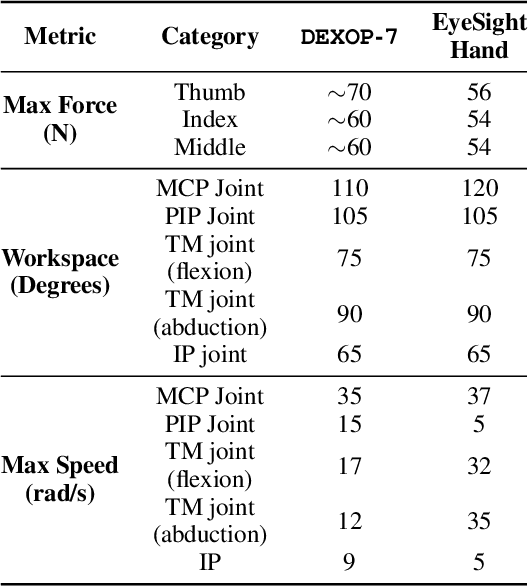
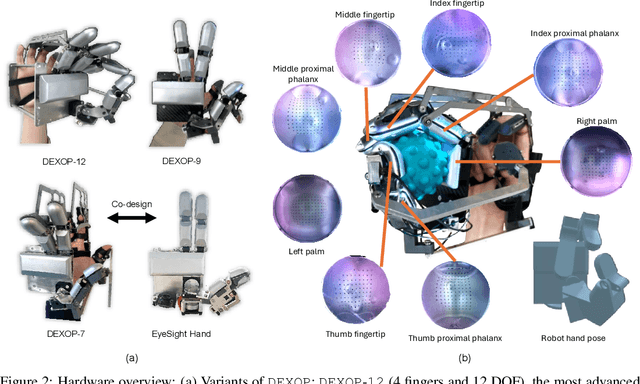

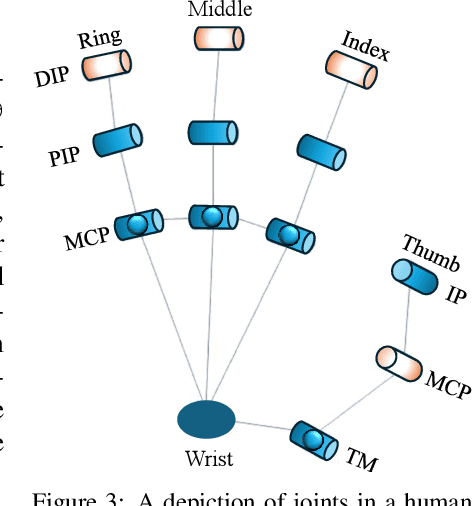
Abstract:We introduce perioperation, a paradigm for robotic data collection that sensorizes and records human manipulation while maximizing the transferability of the data to real robots. We implement this paradigm in DEXOP, a passive hand exoskeleton designed to maximize human ability to collect rich sensory (vision + tactile) data for diverse dexterous manipulation tasks in natural environments. DEXOP mechanically connects human fingers to robot fingers, providing users with direct contact feedback (via proprioception) and mirrors the human hand pose to the passive robot hand to maximize the transfer of demonstrated skills to the robot. The force feedback and pose mirroring make task demonstrations more natural for humans compared to teleoperation, increasing both speed and accuracy. We evaluate DEXOP across a range of dexterous, contact-rich tasks, demonstrating its ability to collect high-quality demonstration data at scale. Policies learned with DEXOP data significantly improve task performance per unit time of data collection compared to teleoperation, making DEXOP a powerful tool for advancing robot dexterity. Our project page is at https://dex-op.github.io.
R3D2: Realistic 3D Asset Insertion via Diffusion for Autonomous Driving Simulation
Jun 09, 2025

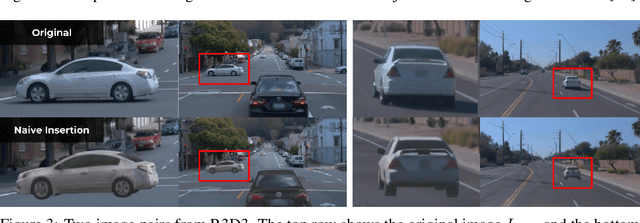

Abstract:Validating autonomous driving (AD) systems requires diverse and safety-critical testing, making photorealistic virtual environments essential. Traditional simulation platforms, while controllable, are resource-intensive to scale and often suffer from a domain gap with real-world data. In contrast, neural reconstruction methods like 3D Gaussian Splatting (3DGS) offer a scalable solution for creating photorealistic digital twins of real-world driving scenes. However, they struggle with dynamic object manipulation and reusability as their per-scene optimization-based methodology tends to result in incomplete object models with integrated illumination effects. This paper introduces R3D2, a lightweight, one-step diffusion model designed to overcome these limitations and enable realistic insertion of complete 3D assets into existing scenes by generating plausible rendering effects-such as shadows and consistent lighting-in real time. This is achieved by training R3D2 on a novel dataset: 3DGS object assets are generated from in-the-wild AD data using an image-conditioned 3D generative model, and then synthetically placed into neural rendering-based virtual environments, allowing R3D2 to learn realistic integration. Quantitative and qualitative evaluations demonstrate that R3D2 significantly enhances the realism of inserted assets, enabling use-cases like text-to-3D asset insertion and cross-scene/dataset object transfer, allowing for true scalability in AD validation. To promote further research in scalable and realistic AD simulation, we will release our dataset and code, see https://research.zenseact.com/publications/R3D2/.
Improved Immiscible Diffusion: Accelerate Diffusion Training by Reducing Its Miscibility
May 24, 2025Abstract:The substantial training cost of diffusion models hinders their deployment. Immiscible Diffusion recently showed that reducing diffusion trajectory mixing in the noise space via linear assignment accelerates training by simplifying denoising. To extend immiscible diffusion beyond the inefficient linear assignment under high batch sizes and high dimensions, we refine this concept to a broader miscibility reduction at any layer and by any implementation. Specifically, we empirically demonstrate the bijective nature of the denoising process with respect to immiscible diffusion, ensuring its preservation of generative diversity. Moreover, we provide thorough analysis and show step-by-step how immiscibility eases denoising and improves efficiency. Extending beyond linear assignment, we propose a family of implementations including K-nearest neighbor (KNN) noise selection and image scaling to reduce miscibility, achieving up to >4x faster training across diverse models and tasks including unconditional/conditional generation, image editing, and robotics planning. Furthermore, our analysis of immiscibility offers a novel perspective on how optimal transport (OT) enhances diffusion training. By identifying trajectory miscibility as a fundamental bottleneck, we believe this work establishes a potentially new direction for future research into high-efficiency diffusion training. The code is available at https://github.com/yhli123/Immiscible-Diffusion.
Generative AI for Autonomous Driving: Frontiers and Opportunities
May 13, 2025Abstract:Generative Artificial Intelligence (GenAI) constitutes a transformative technological wave that reconfigures industries through its unparalleled capabilities for content creation, reasoning, planning, and multimodal understanding. This revolutionary force offers the most promising path yet toward solving one of engineering's grandest challenges: achieving reliable, fully autonomous driving, particularly the pursuit of Level 5 autonomy. This survey delivers a comprehensive and critical synthesis of the emerging role of GenAI across the autonomous driving stack. We begin by distilling the principles and trade-offs of modern generative modeling, encompassing VAEs, GANs, Diffusion Models, and Large Language Models (LLMs). We then map their frontier applications in image, LiDAR, trajectory, occupancy, video generation as well as LLM-guided reasoning and decision making. We categorize practical applications, such as synthetic data workflows, end-to-end driving strategies, high-fidelity digital twin systems, smart transportation networks, and cross-domain transfer to embodied AI. We identify key obstacles and possibilities such as comprehensive generalization across rare cases, evaluation and safety checks, budget-limited implementation, regulatory compliance, ethical concerns, and environmental effects, while proposing research plans across theoretical assurances, trust metrics, transport integration, and socio-technical influence. By unifying these threads, the survey provides a forward-looking reference for researchers, engineers, and policymakers navigating the convergence of generative AI and advanced autonomous mobility. An actively maintained repository of cited works is available at https://github.com/taco-group/GenAI4AD.
Robust Model-Based In-Hand Manipulation with Integrated Real-Time Motion-Contact Planning and Tracking
May 08, 2025Abstract:Robotic dexterous in-hand manipulation, where multiple fingers dynamically make and break contact, represents a step toward human-like dexterity in real-world robotic applications. Unlike learning-based approaches that rely on large-scale training or extensive data collection for each specific task, model-based methods offer an efficient alternative. Their online computing nature allows for ready application to new tasks without extensive retraining. However, due to the complexity of physical contacts, existing model-based methods encounter challenges in efficient online planning and handling modeling errors, which limit their practical applications. To advance the effectiveness and robustness of model-based contact-rich in-hand manipulation, this paper proposes a novel integrated framework that mitigates these limitations. The integration involves two key aspects: 1) integrated real-time planning and tracking achieved by a hierarchical structure; and 2) joint optimization of motions and contacts achieved by integrated motion-contact modeling. Specifically, at the high level, finger motion and contact force references are jointly generated using contact-implicit model predictive control. The high-level module facilitates real-time planning and disturbance recovery. At the low level, these integrated references are concurrently tracked using a hand force-motion model and actual tactile feedback. The low-level module compensates for modeling errors and enhances the robustness of manipulation. Extensive experiments demonstrate that our approach outperforms existing model-based methods in terms of accuracy, robustness, and real-time performance. Our method successfully completes five challenging tasks in real-world environments, even under appreciable external disturbances.
Interleave-VLA: Enhancing Robot Manipulation with Interleaved Image-Text Instructions
May 04, 2025Abstract:Vision-Language-Action (VLA) models have shown great promise for generalist robotic manipulation in the physical world. However, existing models are restricted to robot observations and text-only instructions, lacking the flexibility of interleaved multimodal instructions enabled by recent advances in foundation models in the digital world. In this paper, we present Interleave-VLA, the first framework capable of comprehending interleaved image-text instructions and directly generating continuous action sequences in the physical world. It offers a flexible, model-agnostic paradigm that extends state-of-the-art VLA models with minimal modifications and strong zero-shot generalization. A key challenge in realizing Interleave-VLA is the absence of large-scale interleaved embodied datasets. To bridge this gap, we develop an automatic pipeline that converts text-only instructions from real-world datasets in Open X-Embodiment into interleaved image-text instructions, resulting in the first large-scale real-world interleaved embodied dataset with 210k episodes. Through comprehensive evaluation on simulation benchmarks and real-robot experiments, we demonstrate that Interleave-VLA offers significant benefits: 1) it improves out-of-domain generalization to unseen objects by 2-3x compared to state-of-the-art baselines, 2) supports flexible task interfaces, and 3) handles diverse user-provided image instructions in a zero-shot manner, such as hand-drawn sketches. We further analyze the factors behind Interleave-VLA's strong zero-shot performance, showing that the interleaved paradigm effectively leverages heterogeneous datasets and diverse instruction images, including those from the Internet, which demonstrates strong potential for scaling up. Our model and dataset will be open-sourced.
DexCtrl: Towards Sim-to-Real Dexterity with Adaptive Controller Learning
May 02, 2025


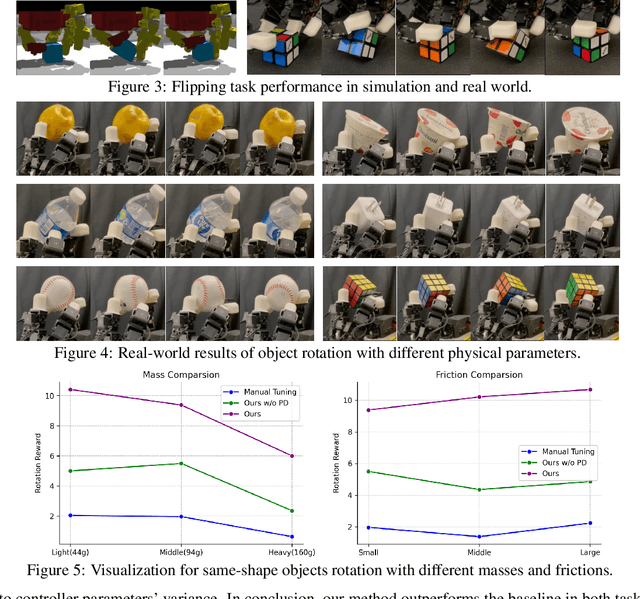
Abstract:Dexterous manipulation has seen remarkable progress in recent years, with policies capable of executing many complex and contact-rich tasks in simulation. However, transferring these policies from simulation to real world remains a significant challenge. One important issue is the mismatch in low-level controller dynamics, where identical trajectories can lead to vastly different contact forces and behaviors when control parameters vary. Existing approaches often rely on manual tuning or controller randomization, which can be labor-intensive, task-specific, and introduce significant training difficulty. In this work, we propose a framework that jointly learns actions and controller parameters based on the historical information of both trajectory and controller. This adaptive controller adjustment mechanism allows the policy to automatically tune control parameters during execution, thereby mitigating the sim-to-real gap without extensive manual tuning or excessive randomization. Moreover, by explicitly providing controller parameters as part of the observation, our approach facilitates better reasoning over force interactions and improves robustness in real-world scenarios. Experimental results demonstrate that our method achieves improved transfer performance across a variety of dexterous tasks involving variable force conditions.
Unified Manipulability and Compliance Analysis of Modular Soft-Rigid Hybrid Fingers
Apr 18, 2025Abstract:This paper presents a unified framework to analyze the manipulability and compliance of modular soft-rigid hybrid robotic fingers. The approach applies to both hydraulic and pneumatic actuation systems. A Jacobian-based formulation maps actuator inputs to joint and task-space responses. Hydraulic actuators are modeled under incompressible assumptions, while pneumatic actuators are described using nonlinear pressure-volume relations. The framework enables consistent evaluation of manipulability ellipsoids and compliance matrices across actuation modes. We validate the analysis using two representative hands: DexCo (hydraulic) and Edgy-2 (pneumatic). Results highlight actuation-dependent trade-offs in dexterity and passive stiffness. These findings provide insights for structure-aware design and actuator selection in soft-rigid robotic fingers.
 Add to Chrome
Add to Chrome Add to Firefox
Add to Firefox Add to Edge
Add to Edge